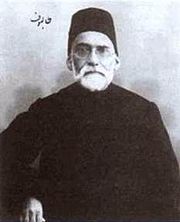- Mirza Abdul'Rahim Talibov Tabrizi
-
Mirzā Abdul'Rahim Tālibov Najjār Tabrizi (1834, Tabriz — 1911, Temir-Khan-Shura, named Buinaksk since 1922) (Persian: ميرزا عبدالرحیم طالبف نجار تبریزی) was an Iranian Azerbaijani[1][2] intellectual and social reformer. He was born in the Sorkhab district of Tabriz, Iran. Both his father, Abu-Tālib Najjār Tabrizi, and grandfather, Ali-Morad Najjār Tabrizi, were carpenters (whence the name Najjār). No information concerning the maternal side of his family is available.
In 1851, Talibov emigrated to Tbilisi (Tiflis), the administrative capital of the Russian Caucasus, and began a new life there (see Treaty of Golestan and Treaty of Turkmenchay). According to one Iranian source, Talibov attended school in Tbilisi and studied modern sciences, however there is no independent evidence in support of this report. It has been suggested that Talibov may in fact never have received a formal education in Russia. In a letter written to an Iranian friend, he indicated that he produced his major works through relying on personal reading and self-discipline.
In Tbilisi, Talibov worked for an Iranian businessman, named Mohammad-Ali Khan, who had emigrated to Transcaucasia from the city of Kashan. Mohammad-Ali Khan was a contractor who had accumulated much of his wealth from obtaining concessions for construction of roads and bridges in Transcaucasia. After years of working for the wealthy compatriot, Talibov must have saved a sufficient amount of capital to start his own construction business. He also moved from Tbilisi to Temir-Khan-Shura (Buinaksk, since 1922), the provincial capital of Dagestan, where he bought a comfortable house, built a small private library and married a Shia woman from Derbent.
Talibov wrote all of his works after the age of fifty-five. He had by then attained a degree of financial security that enabled him to devote the next twenty-one years of his life to writing and translating from Russian into Persian. With the exception of his last two books, he published all of his works at his own expense. Of his last two books, the first, Īzāhāt dar Khosus-e Azādi (Explanations Concerning Freedom), was published in Tehran after the victory of the Iranian Constitutional Revolution of 1906, and the second, Siyāsat-e Tālibi (Tālibian Politics), was published posthumously in Tehran a few months after his death in 1911.
During his lifetime, two of Talibov's works, namely Ketāb-e Ahmad yā Safineh-ye Tālebi (Ahmad's Book or the Talibian Vessel) and Masālek'ol-Moh'senin (The Ways of the Charitable), achieved great eminence. Ketāb-e Ahmad, which consists of two volumes, was inspired by Jean Jacques Rousseau's tract on education, Emile. The book is based on conversations between the author and his fictional seven-year-old son, Ahmad, whose searching and inquisitive mind compels his father to expand on a wide range of scientific, historical, political and religious topics.
Contents
References
- ^ Afary, Janet (1996). The Iranian constitutional revolution, 1906-1911: grassroots democracy. Columbia University Press. p. 40. http://books.google.com/books?id=R1HnWr4rZucC&pg=PA40. "He read the works of Transcaucasian Azeri intellectual, Abd al-Rahim Talibov"
- ^ DeGroot, Joanna (1998). Pierson, Ruth Roach; Chaudhuri, Nupur; McAuley, Beth. eds. Coexisting and Conflicting Identities [Nation, empire, colony: historicizing gender and race]. Indiana University Press. p. 145. ISBN 9780253211910. http://books.google.com/books?id=kO8yRHeDxVcC&pg=PA145. "...the Azeri-Iranian Talibov/Talibzadeh linked the threat of "our pure Shari'a" (i.e. Iranian Islamic tradition) to the dominance of foreigners over Iranians..."
- Mehrdad Kia, Nationalism, Modernism and Islam in the Writings of Talibov-i Tabrizi, Middle Eastern Studies, Vol. 30, No. 2, pp. 201-223 (1994).
- Mehrdad Kia, Pan-Islamism in Late Nineteenth-Century Iran, Middle Eastern Studies, Vol. 32, No. 1, pp. 30-52 (1996).
Further reading
- Ahmad Kasravi, Tarikh-e Mashruteh-ye Iran (تاریخ مشروطهٔ ایران) (History of the Iranian Constitutional Revolution), in Persian, 951 p. (Negāh Publications, Tehran, 2003), ISBN 9643511383. Note: This book is also available in two volumes, published by Amir Kabir Publications in 1984. Amir Kabir's 1961 edition is in one volume, 934 pages.
- Ahmad Kasravi, History of the Iranian Constitutional Revolution: Tarikh-e Mashrute-ye Iran, Volume I, translated into English by Evan Siegel, 347 p. (Mazda Publications, Costa Mesa, California, 2006). ISBN 1568591977
External links
- Abdul'Rahim Talibov Tabrizi, Azin-Dad (in Persian). [1]
See also
- Mirza Jahangir Khan
- Mirza Fatali Akhundov
- Mohammad-Ali Jamalzadeh
Categories:- Iranian people
- People from Tabriz
- 1834 births
- 1911 deaths
Wikimedia Foundation. 2010.

